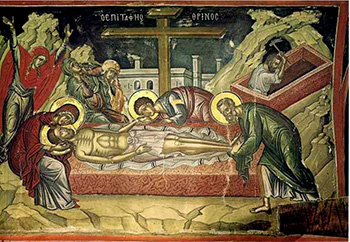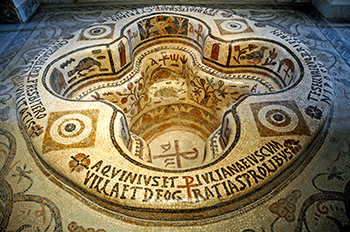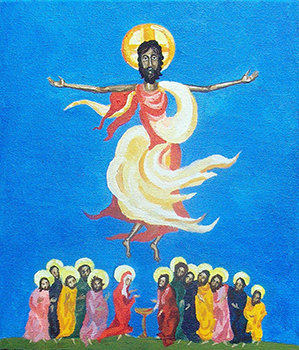From Our Archives
Debie Thomas, "What To Fear" (2020); Dan Clendenin, "His Eye is on the Sparrow" (2014); Brad Keister, "How Do We Love Burma?" (2008).
For Sunday June 25, 2023
Lectionary Readings (Revised Common Lectionary, Year A)
Genesis 21:8-21 or Jeremiah 20:7-13
Psalm 86:1-10, 16-17 or Psalm 69:8-20
Romans 6:1b-11
Matthew 10:24-39
This Week's Essay
Michael Fitzpatrick is a lay teacher and preacher in The Episcopal Church. After growing up in the rural northwest, he served over five years in the U. S. Army as a Chaplain's Assistant, including two deployments to Iraq. After completing his military service, Michael has done graduate work in literature and philosophy. He is now finishing his PhD at Stanford University.
“Christ died for our sins.”
The beating heart of the Christian faith. Unlike religions founded on a pure revelation or a set of wisdom teachings, Christianity is rooted in the claim that God did something in history that changed all our lives. For those of us in parish communities that celebrate Holy Communion every Sunday, God’s action is portrayed in the breaking of bread and the giving of red wine. We even have a grand sounding word for this divine action: the Atonement.
Yet the Atonement has of late become somewhat contentious to talk about. Every generation has to find their own way into the language of the Church, and many today are finding the Atonement off-putting or even downright unloving. An innocent person had to die because of our sins? Why couldn’t God just forgive us? How does Jesus’ death help us? Can’t we just focus on the Resurrection? That’s our hope!
The challenge of the Atonement is made more difficult when cultural currents in the West fasten onto a particular presentation in which the Crucifixion is God’s act of punishment, afflicting Jesus on the cross in our place and for our sins. Jesus took upon himself our evil and gave us his righteousness. While one should not too quickly dismiss the rhetorical power of this kind of substitutionary story for some communities, the pastoral realities in many congregations are that this paints a seemingly vindictive and unloving picture of the God who is supposed to be saving us through this act.
 |
|
The Burial Lamentations by Theophanes the Cretan, 16th century, located in the Holy Monastery of Stavronikita, Greece.
|
Part of the challenge is that for many of us, we’ve lost access to the Bible’s central stories about the Atonement, and so we are unsure if there is a better story to tell than the substitutionary story. I believe that the Bible does provide a better story, and not merely the complementary Christus Victor narrative that in his Resurrection Christ conquered Sin and Death. While also true, there is more to the story and we should boldly tell it.
This Sunday is the once-every-three-years opportunity in the lectionary to read the opening of Romans 6. While many of us know these words in the context of our baptisms, we should consider them among the central images of scripture on the meaning and saving power of the Atonement. What’s surprising about this passage is that its narrative excludes a substitutionary story altogether.
St. Paul tells us that in being baptized we are baptized into Christ’s death. In the substitutionary story, our sins are so bad that we deserve ultimate death, and the only way to be saved from that punishment is for Christ to substitute himself and suffer death so that we don’t have to. Yet nowhere in the New Testament does it say that we don’t have to die; instead, Paul writes that what we need is to die with Christ!
We have been “buried with Christ” by baptism, “so that, just as Christ was raised from the dead by the glory of the Father, so we too might walk in newness of life.” In other words, we’re in the tomb with Jesus, not for the sake of death, but for the sake of life.
Why would we need to die? Why would anyone in their right mind want to be united with Christ in his death?
Paul explains that if we are united with Christ in his death, we’ll be united with him in his resurrection. We die in order to live. Why can’t we have newness of life without first dying? We come to Paul’s central story: “We know that our old self was crucified with him so that the body of sin might be destroyed, and we might no longer be enslaved to sin. For whoever has died is freed from sin.” We’re both crucified and buried with Christ, so that our life enslaved by sin is destroyed.
On this story, death is not a punishment at all; quite the contrary, death is an instrument of liberation —“whoever has died is freed from sin.” The problem is, we cannot kill ourselves to free ourselves from sin. What we need is someone to ‘make a way out of no way’ for us to walk the path of death into life. In his actual, historical death, Christ makes it possible for all of us to spiritually die (and no less real for that) with him so that, in his actual, historical resurrection, we have new life liberated from sin. As Paul triumphantly concludes, because Christ has been raised, “death no longer has dominion over him.” So, in our union with Christ, we can consider ourselves “dead to sin and alive to God in Christ Jesus.”
 |
|
Kelibia baptistry in the Church of Felix, 6th century, located in Demna, Tunisia.
|
In this stunning passage, Paul proclaims that, contrary to the substitutionary narrative that Christ died because we deserve to die, Christ died because we need to die! As New Testament scholar John A. T. Robinson writes in his commentary on Romans, “Christ stands as our representative, not as our replacement.” He does what we need, not what he needs for himself, by opening up a way for us to die to sin. “Of course,” Robinson continues, “Christ does something we could never do for ourselves. He is there because we are not.” We cannot go to the cross to liberate ourselves from sin! But Christ’s action has nothing to do with punishment; he does for us what we cannot do for ourselves so that we might unite ourselves with him and live.
Robinson sums up Paul’s story of the Atonement this way: “[Christ] died to sin not so that we shall not have to (as our substitute) but precisely so that we can (as our representative).” The substitutionary story is not only off-putting but obscures the biblical picture of the Atonement. It suggests that the goal of Christian faith is to avoid the death that is ours. But our death is not our punishment — it’s our need, just as our resurrection is not our reward but our need. God’s act is gracious, not merited. The Atonement is God’s liberating act to rescue a fallen humanity from our captivity to sin, by breaking the power of sin over us and uniting us with him who died “once for all” (emphasis added).
This story is not just a one-off narrative in Romans but a remarkable thread throughout Paul’s letters. In a justly famous passage on reconciliation in 2 Corinthians 5.14–15, Paul writes, “For Christ’s love compels us, because we are convinced that one died for all, and therefore all died. And he died for all, that those who live should no longer live for themselves but for him who died for them and was raised again” (emphasis added). Christ died for the sins of all, not so that all would not have to die, but so that all die with him. He did this so that we are dead to living for ourselves, and alive to living for him who died for us.
Paul’s repeated acclamation is that “if anyone is in Christ, the new creation has come: The old has gone, the new is here!” (2 Cor. 5.17). All socially constructed identities cease to count for or against us because our body that carries those identities has died: “Neither circumcision nor uncircumcision [by human hands] means anything; what counts is the new creation” (Gal. 6.15). Our whole self is crucified and buried with Christ, so that our life is resurrection life: “In [Christ] you were also circumcised with a circumcision not performed by human hands. Your whole self ruled by the flesh was put off when you were circumcised by Christ, having been buried with him in baptism, in which you were also raised with him through your faith in the working of God, who raised him from the dead” (Col. 2.11–12, emphasis added).
 |
|
The Ascension, oil on canvas by Soviet Union-refugee Alexey Pismenny, 2006.
|
Because we have died with Christ we are no longer slaves to the system of values imposed on us by earthly powers and principalities. Paul writes, “Since you died with Christ to the elemental spiritual forces of this world, why, as though you still belonged to the world, do you submit to its rules: ‘Do not handle! Do not taste! Do not touch!’? These rules, which have to do with things that are all destined to perish with use, are based on merely human commands and teachings” (Col. 2.20–22).
So the story of the Atonement that Christ died so that we wouldn’t have to is simply not the story Paul is telling. Surprisingly, the substitutionary story does not appear in the New Testament at all. Nowhere does it say Christ was punished on our behalf. Returning to Robinson’s scholarship, “The New Testament never says that God punishes Christ: in fact the verb and noun for ‘punishment’ are only used twice each in the whole of the New Testament, and never of God or Christ.”
It’s time we reclaim and boldly declare the centrality of the Atonement to our faith. The story I’ve been telling is not a substitutionary but a participatory story. Rather than Christ’s death being a substitution for ours, Christ dies for us to participate in his, so that we also participate in his glorious resurrection. “For you died, and your life is now hidden with Christ in God” (Col. 3.3). There are other good stories of Atonement in the New Testament — stories of debts being forgiven, of the lamb being sacrificed, of consciences being cleansed, of Christ conquering the powers, of Christ ransoming our freedom. My prayer is that this Sunday we will hold up the participatory story told in Romans 6.1–11 as language that can breathe new life into the heart of our tradition, allowing people the freedom and joy to once again find truth and liberation in the old, old story.
—All citations taken from John A. T. Robinson, Wrestling with Romans, 1979, p. 48.
Weekly Prayer
Jill Bergkamp
A pane breaks into water as we enter death
and burial to imitate Christ. Faith is measuredthis way, by one’s willingness to submit
to what one cannot comprehend. We rise upas new creatures, but in what sense have we
shifted? In those seconds under water’ssmooth door, do our bodies lap over
this world’s edge to the next? Do the angelswho see us rejoice
to bear witness before we rise up, closingthe door between us? Our lives’ balance
on the wing of what we give up, yet desire.A bird imitates, but is said to have no
perception. Yet some believe it was a birdwho plunged the primordial sea,
bringing mud to the surface to form the earthwe’re made from; their wings opening in the shape
of a cross, our fondest dreams of flight.Jill Bergkamp is a California native who now lives in Florida. A graduate student in Florida Atlantic University’s MFA program in Poetry, Jill has served as Director of Children’s Ministries at the United Methodist Church of the Palm Beaches, as well as teaching English Composition at Palm Beach Atlantic University. She has published poems in Third Coast, The Southeast Review, Sugar House Review, Rattle, and Christian Century, and was the recipient of a Rona-Jaffe Breadloaf Poetry Scholarship. --"Baptism" originally published in The Christian Century, 23 December 2015.
Michael Fitzpatrick welcomes comments and questions via m.c.fitzpatrick@outlook.com
Image credits: (1) Wikimedia.org; (2) Wikimedia.org; and (3) Pinimg.org.





